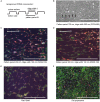Validation and Optimization of an Image-Based Screening Method Applied to the Study of Neuronal Processes on Nanogrooves
- PMID: 30459563
- PMCID: PMC6232373
- DOI: 10.3389/fncel.2018.00415
Validation and Optimization of an Image-Based Screening Method Applied to the Study of Neuronal Processes on Nanogrooves
Abstract
Research on neuronal differentiation and neuronal network guidance induced through nanotopographical cues generates large datasets, and therefore the analysis of such data can be aided by automatable, unbiased image screening tools. To link such tools, we present an image-based screening method to evaluate the influence of nanogroove pattern dimensions on neuronal differentiation. This new method consists of combining neuronal feature detection software, here HCA-Vision, and a Frangi vesselness algorithm to calculate neurite alignment values and quantify morphological aspects of neurons, which are measured via neurite length, neuronal polarity, and neurite branching, for differentiated SH-SY5Y cells cultured on nanogrooved polydimethylsiloxane (PDMS) patterns in the 200-2000 nm range. The applicability of this method is confirmed by our results, which find that the level of alignment is dependent on nanogroove dimensions. Furthermore, the screening method reveals that differentiation and alignment are correlated. In particular, patterns with groove widths >200 nm and with a low ridge width to pattern period ratio have a quantifiable influence on alignment, neurite length, and polarity. In summary, the novel combination of software that forms a base for this statistical analysis method demonstrates good potential for evaluating tissue microarchitecture, which depends on subtle design variation in substrate topography. Using the screening method, we obtained automated and sensitive quantified readouts from large datasets.
Keywords: SH-SY5Y cells; high-content screening; nanogrooves; neurite development; neuronal development; neuronal differentiation.
Figures







References
-
- Bremus-Koebberling E. A., Beckemper S., Koch B., Gillner A. (2012). Nano structures via laser interference patterning for guided cell growth of neuronal cells. J. Laser Appl. 24:042013 10.2351/1.4730804 - DOI
-
- Encinas M., Iglesias M., Liu Y., Wang H., Muhaisen A., Ceña V., et al. (2000). Sequential treatment of SH-SY5Y cells with retinoic acid and brain-derived neurotrophic factor gives rise to fully differentiated, neurotrophic factor-dependent, human neuron-like cells. J. Neurochem. 75 991–1003. 10.1046/j.1471-4159.2000.0750991.x - DOI - PubMed
LinkOut - more resources
Full Text Sources

